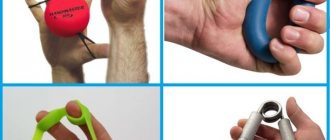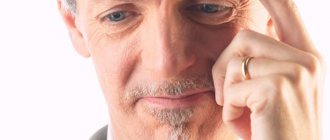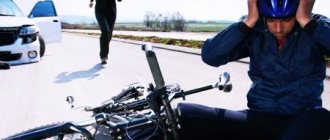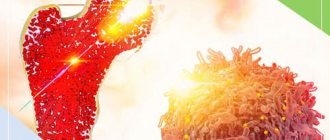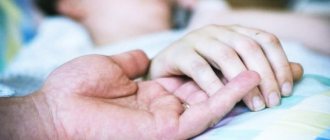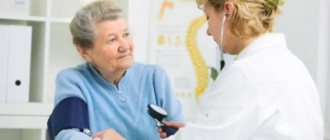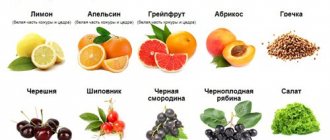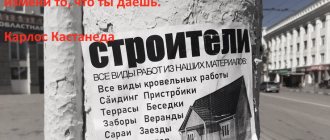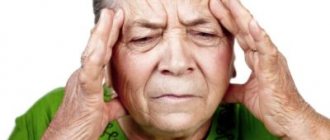Rehabilitation after a stroke at home requires regular use of medications and adaptation to the new condition. Help is aimed at restoring intellectual, speech abilities, memory, and movements. In any condition, it is important to provide psychological support.
The quality of rehabilitation at home depends entirely on the family. If the victim is surrounded by real care, then at least the skills of independent self-care will be restored. And this is already enough for everyone around. Including from a moral point of view.
Stroke
One of the most difficult diseases in terms of treatment and recovery is stroke . Depending on the pathogenesis, diseases of ischemic and hemorrhagic types are distinguished. In the first case, due to disruption of cerebral blood supply and lack of blood flow, necrosis of brain tissue occurs. In the second, hemorrhage occurs through destruction in the walls of blood vessels.
For reference. The reasons leading to different types of stroke are the same. These are high blood pressure, atherosclerosis, tumors. Factors such as obesity, physical inactivity, constant tension, overwork, and bad habits increase the risk of a stroke.
An important difference in the development of hemorrhagic stroke and ischemic stroke is that in the first case, too thin blood leads to a stroke, in the second - increased viscosity. This difference plays an important role in diagnosis, treatment and subsequent recovery.
Stages of development
The disease goes through several stages in its development.
Acute lasts for 21 days from the moment of impact. It distinguishes the most acute stage - a duration of five days, characterized by an increase in symptoms . The rapidity of diagnosis at this stage and proper treatment make it possible to restore the functions of some neurons that did not die, but were damaged due to lack of nutrients.
The early recovery period after a stroke follows the acute stage and lasts up to six months. At this time, compensation for disturbances and restoration of normal nutrition of neurons begins.
The rehabilitation stage conventionally begins 6 months after the impact and lasts on average up to a year. At this moment, glial formations and cysts form in the lesions.
The last stage is the residual stage, lasting throughout the rest of life.
For reference. Despite the fact that, based on the terminology, it seems that recovery after a stroke begins 3 weeks after the stroke, doctors recommend starting this process immediately after achieving stability in the patient’s condition.
A stroke always leaves an indelible mark on the life of a person who has suffered a brain stroke. Most patients experience loss of movement in their limbs after a stroke. But even in the most severe cases, do not despair: the body has great self-healing capabilities. Knowing this and the patient’s great desire to return to a full life, as well as the help of loved ones help to overcome the disease. That is why doctors pay special attention to the rehabilitation period after a stroke.
We asked rehabilitation specialist, Candidate of Medical Sciences Elena Vasilyevna LITVINOVA (Nizhny Novgorod) to tell us more about recovery methods.
— After a stroke, consequences are inevitable. How pronounced are they?
— It is almost impossible to accurately predict the consequences of a stroke in advance. Less than 20% of patients return to a full life.
One of the most dangerous complications of a stroke is impaired movement in the form of paresis (decreased range of motion and muscle strength) and paralysis (complete lack of movement). Therefore, rehabilitation measures for patients should begin in the first days after suffering a brain stroke.
— What determines the degree and time of restoration of impaired functions?
— There are two main causes of cerebrovascular accident: hemorrhage in the brain as a result of a rupture of the vessel wall (hemorrhagic stroke) and blockage of the lumen of the vessel by a thrombus or atherosclerotic plaque (ischemic stroke). In both cases, some area of brain tissue dies, deprived of the flow of fresh blood. And around this focus there is a zone of neurons (nerve cells), which balances between life and death. So these neurons can be brought back to life by sending them a stream of motor impulses. When a patient after a stroke begins rehabilitation measures, these neurons begin to come to life, other parts of the brain are connected, which take on the lost functions of the dead area. After a hemorrhagic stroke (more severe), the quality of recovery may be even better than after an ischemic injury, since the zone of inactivated neurons (ready for recovery) in the first case is much larger.
— During a stroke, does only one half of the body suffer or both?
— If a circulatory disorder occurs in the right hemisphere of the brain, then the left half of the body suffers. In case of a catastrophe in the left hemisphere, the same phenomena are observed on the right. Sometimes the part of the brain that controls the movements of the entire body dies, but this happens rarely.
— How can relatives help the patient in his recovery?
— Relatives bear great responsibility for the health of the patient; at this time, maximum perseverance, attention, and patience are required from them, since relatives have to scrupulously follow all the doctor’s recommendations.
What should you do at first?
* It is necessary to turn the patient on one side or the other every 2 hours.
* Several times a day you can perform a light back massage (stroking, rubbing) to avoid congestion, primarily in the lungs.
* For better lung function, every 2 hours, if possible, the patient should take 2-3 deep breaths.
* In the morning and evening, the patient should be washed with warm water and shampoo.
* It is necessary to ensure the prevention of bedsores (an inflatable rubber circle 1-2 cm high is placed under the sacrum, cotton-gauze 'bags' are placed under the heels, etc.).
* In case of pathology in the veins, it is advisable to bandage the patient’s legs for several hours to avoid stagnation of blood in the lower extremities.
* It is better to position the patient’s bed so that the affected part of the body is located on the side of the source of irritation (door, TV, etc.). This will stimulate movement in the affected limbs.
* It is advisable for patients to lie on both sides and carry out the so-called “position treatment” several times a day.
After a stroke, the muscles are initially in a relaxed state, and then their tone begins to increase. The sore arm seems to be “shortened”: the shoulder is brought to the body, the hand and fingers are bent, and the sore leg seems to “lengthen”: the lower leg is extended at the knee joint, and the foot is in the position of plantar flexion (“dangling”). When walking, patients usually move their leg to the side and move it in a circle (“move”).
To restore correct movements from the first days after a stroke and throughout the entire rehabilitation period, positional treatment, passive and active gymnastics, breathing exercises and other methods of combating the disease are carried out.
The most effective treatment lasts for the first 3-6 months. There are 3 stages of recovery after a stroke: the early period is up to 3 months, the late period is up to a year, and after a year residual impairments in motor functions are compensated.
— Do medications help with muscle spasms?
— There is a whole group of muscle relaxant drugs that act on spastic (spasmodic) muscles. But these drugs should not be abused. The fact is that it is undesirable to completely relieve muscle spasms, since in some cases, with incomplete restoration of movements, normalization of tone in the leg can lead to a decrease in its supporting function. As a result, the person will find it difficult to walk.
Rehabilitation treatment includes a complex of different methods: physiotherapy, physical rehabilitation, acupuncture, swimming pool exercises and much more. Patients feel great benefits from performing ideomotor exercises that are done mentally. In case of paralysis and deep paresis, the victim is shown what movements are possible in the joints and is asked to mentally perform exercises with each affected limb at least 4 times a day for 15 minutes. By the way, Valentin Ivanovich Dikul began his recovery with exercises performed mentally. The conducted studies confirm the fact that when using ideomotor exercises, the patient’s rehabilitation is more effective.
We must not forget about healthy muscles, which also need to be trained. The better a healthy limb works, the faster the recovery in the affected part of the body.
Evgenia NIKOLAEVA.
Diagnostics
After examining the patient and studying the medical history, a magnetic resonance or computed tomography scan of the brain is performed. Such research is necessary because the symptoms of stroke can be similar to those of meningitis, brain abscess and many other diseases.
After the research, the type of stroke is determined and the most appropriate treatment methods are selected.
By the way
It is advisable to have glycine in your home medicine cabinet. Many doctors consider this drug a neuroprotector, that is, a substance that protects brain tissue.
If you experience unpleasant sensations (primarily weakness) that first appear in your arm or leg, or speech disorder, you should put 5 glycine tablets under your tongue. With the help of such prevention, it is possible to prevent brain damage to some extent.
What is a microstroke
This word refers to temporary disorders of cerebral circulation that last less than one day. Doctors call such small foci of cerebral ischemia lacunar.
The origin of microstrokes is associated with changes in the walls and blockage of very small arteries located deep in the brain.
If a lacunar stroke affects an area where there are no critical nerve pathways, then adverse symptoms can be avoided. But, gradually accumulating, microstrokes impair memory, attention, and balance when walking.
If a lacunar stroke develops in an area where important pathways from the brain to the spinal cord are concentrated, then the consequences will be very severe. In this case, a sign of a stroke may be muscle weakness in an arm or leg.
Focus on health
After a stroke, it is imperative to lead a healthy lifestyle: stop smoking and drinking alcohol, switch to an anti-sclerotic diet, and engage in feasible physical activity.
Nicotine worsens the prognosis of the disease and significantly increases the likelihood of a recurrent stroke.
You need to eat foods with low cholesterol. This means that you cannot eat a lot of animal fats, which are found in butter, mayonnaise, fatty cheeses, cottage cheese, fatty pork, lard, and chicken eggs (you can eat no more than two of these per week).
It is recommended to increase the amount of vegetables, fruits and vegetable oils in the diet. It is believed that vegetable oils together with vegetables reduce cholesterol levels in the blood.
The amount of salt in the diet should be reduced, as it retains fluid in the body and increases blood pressure.
Physical education classes are carried out under the control of blood pressure: during exercise, the upper pressure figure should not be higher than 180-200.
Complications
In many cases, a stroke results in death. But even if this disease leaves a person alive, it rarely goes away without complications.
Paralysis is considered a common consequence of a stroke. A person loses the ability to move one or both limbs on one or both sides. There is complete paralysis, in milder cases – muscle weakness, which does not allow normal movement, walking, or self-care. Often victims of the disease begin to suffer from convulsive seizures, severe pain, and bowel disorders.
Motor disorders are associated with loss of coordination and inability to perform voluntary actions.
A victim of the disease who has retained the ability to walk can be recognized by a sloping, deformed face, limbs bent in a specific way, and impaired gait.
Bedridden patients develop bedsores, which, in turn, lead to severe tissue damage and intoxication of the body.
Visual impairment and, in some cases, hearing impairment are observed. Often victims lose normal speech. She becomes confused and inarticulate. It is difficult for the patient to find words and combine them into sentences and text. In some cases, the patient can only moo.
Patients often lose the skills of reading, counting, logical operations, anticipating the development of events, and cannot solve simple problems. Lost connection with reality. Patients live in their own world, far from reality, and do not understand where they are. Consciousness becomes narrowed, the ability to create and understand creativity disappears.
The psycho-emotional sphere suffers. Most victims become prone to depression, apathy, anxiety, and suffer from lack of confidence in themselves and their future.
Emotional lability is noted. Patients become aggressive. Sometimes being with them is unsafe for others. Persecution mania and phobias develop.
For reference. In approximately 10% of cases, victims develop epilepsy. In elderly patients, exacerbation of cardiovascular, respiratory diseases, and pathologies of the genitourinary system is noted.
General principles of rehabilitation
The treatment and rehabilitation program for patients after a stroke includes a variety of measures to normalize the condition and maintain a decent standard of living.
Rehabilitation methods after stroke are aimed at:
- Proper care to prevent the formation of bedsores and the development of secondary diseases.
- Providing a healthy diet with sufficient vitamins and nutrients.
- Restoration of motor functions.
- Psycho-emotional rehabilitation.
- Normalization of the cognitive sphere.
- Speech restoration.
Recovery stages
Directly in the residual process there are four stages. The purpose of the first is to support the most important functions of the body and preserve life. It often corresponds to the acute period.
At the second stage of recovery after a stroke, patients, if necessary and possible, are taught self-care skills.
On the third stage, conditions are created for restoring the ability to move, sit, talk, and think.
The main direction at the fourth stage of rehabilitation for stroke is related to the restoration of fine motor skills, speech, thinking, and professional skills.
Recovery time
The timing of recovery after a stroke and the normalization of functions are influenced by the severity, extent of the lesion, the age of the patient, and the type of stroke.
It takes up to two months to partially restore minimal visual impairment, mobility of arms and legs, and coordination after an ischemic stroke.
Patients and their relatives are often interested in the question of whether it is possible to achieve full recovery after a stroke. In the case of a mild lesion, the answer will be in the affirmative; it will take up to three months. Probably, the basis of this process is a return to the pre-stroke state due to restoration of functions and incomplete cell damage.
The recovery period after a stroke, characterized by severe, persistent disorders, is 6 months. Usually only self-care skills return.
For reference. Very rarely, complete recovery is possible; in this case, the rehabilitation process takes about a year. Recovery processes occur due to the fact that some cells take on the functions of the affected ones.
In very severe forms, patients can sit after two years. Full recovery is impossible because the affected area is too large. The surviving cells cannot take on compensatory functions.
It usually takes much longer for speech and sensation to return than for normal movements.
In general, it is believed that rehabilitation after an ischemic stroke is easier than after a hemorrhagic one.
Principles of rehabilitation
Usually, after discharge, doctors give advice on how to recover from a stroke. Here are some basic principles.
For reference. Normalization of lost functions can only be achieved with regular exercise. Classes must begin as early as possible. Let it be at first only attempts to roll your eyes or clench your fists.
As the symptoms of a stroke disappear, classes cannot be stopped.
Post-stroke aggression and rage
In the acute and subacute phase of stroke, patients often experience causeless, uncontrollable aggression, outwardly expressed by an angry attitude towards others and the commission of violent acts. This phenomenon is described by doctors as post-stroke rage. The prevalence of this problem reaches 35% of cases in the acute stage of stroke. As the crisis subsides, the level of aggression and rage decreases.
The mechanism of development of post-stroke rage has been well studied. It has been established that such a psychoemotional disorder is often associated with damage to the ventral prefrontal cortex of the brain.
A stroke survivor may exhibit different types of aggressive reactions. The most common forms are:
- physical aggression, which involves using physical force to attack another person;
- indirect aggression, which means humiliation of another person through slander, gossip, and malicious statements;
- explosions of rage that do not have a specific addressee (stomping feet, banging fists on the table, breaking dishes, slamming doors);
- verbal aggression - demonstration of one’s feelings through screams, threats, curses;
- passive or active negativism – actions aimed at undermining the authority of medical personnel.
Any manifestations of aggressive behavior require immediate consultation with a psychotherapist and corrective work.
Drug therapy
Rehabilitation includes drug therapy . It is aimed at comprehensively maintaining the body’s performance, improving blood circulation, and protecting neurons.
Important. The basic principle of using drug therapy is following the doctor’s recommendations.
Appointed:
- Drugs to improve cerebral blood supply. This is Cerebrolysin, Cavinton.
- Medicines aimed at activating metabolic processes. Cortexin and Solcoseryl tablets are used. Actovegin is administered intravenously.
- Nootropic drugs. Their goal is to activate thinking and memory. They help restore brain cells. Prescribed Piracetam, Lucetam.
- Drugs that improve the transmission of impulses in the nervous system. Vinpocetine is used.
- Sedatives. Medicines of this type help relieve anxiety and calm down. Persil, tinctures of valerian, motherwort are prescribed. Glycine not only has a calming effect, it also has a stimulating effect on mental abilities.
It is recommended to take most of these medications in courses, each lasting up to six months. Physiotherapy with medications is sometimes recommended.
Recovery from an ischemic stroke includes the use of blood thinners.
Patients are treated symptomatically. Muscle spasms are relieved with muscle relaxants: Sirdalud, Mydocalm. It is recommended to treat convulsive symptoms with Phenytoin and valproic acid. The duration of the course and frequency of administration are determined by the doctor.
Care
In recovery after a stroke at home, much attention is paid to care. The room in which a person spends the most time must be kept clean and tidy. Be sure to ventilate it every day. At the same time, it is important not to give the patient a cold. A weakened body after a stroke is susceptible to infectious diseases and pneumonia.
Preparations are made to provide the patient with the necessary care even before he is discharged. You need to purchase special diapers, a bedpan, and a mattress against bedsores. Place a pole or hang reins next to the bed so that a person can pull himself up, sit down, and stand up. It is advisable to lay a thick soft carpet near the bed. An accidental fall will reduce pain.
An unfortunate fall may result in serious injury. The author of these lines’ father fell unsuccessfully after standing up abruptly. This fall resulted in a transition into a coma followed by death after 10 days of coma.
In the morning and evening, it is advisable to wash the stroke victim or at least wipe him with a warm, damp towel. His eyes and mouth are washed and his teeth are brushed.
For reference. To prevent bedsores, the sheet is pulled so that there are no folds, and all the crumbs that remain after eating are removed. The immobilized patient is turned on his side every 2 hours. When bedsores form, they are treated with an alcohol solution and talc.
Rehabilitation after a stroke at home
Without continued treatment for stroke at home, a person develops irreversible anatomical and functional changes.
Only in the early recovery period, up to 6 months from the moment of illness, is it possible to return to maximum activity. The first 3 months are important to activate motor skills.
A rehabilitation program for home is developed by doctors taking into account the severity of the disease, the degree of independence of a person at home and his age. These are individually developed methods of influence that complement the prescribed medications.
Continuing recovery in the post-stroke period helps:
- prevent the development of complications;
- stop the progression of impaired functions;
- prevent relapse;
- partially or completely restore lost abilities.
Diet after stroke
Diet therapy is considered a fundamental factor in creating a nutrition program at home. Table No. 10 was developed for the group of cardiovascular diseases. This is a balanced food, the task of which is to normalize blood pressure and blood circulation, reduce the load on the heart and blood vessels.
At home, the diet is designed to:
- reduce the calorie content of dishes;
- limit salt intake;
- reduce cholesterol;
- increase intake of foods with potassium and magnesium.
To get used to the new menu and not feel hungry, the daily diet is divided into 4-5 meals. The list of products containing substances necessary for the body includes:
- fish;
- lean meats;
- nuts, dried fruits;
- cereals;
- fruits vegetables;
- vegetable oils.
Avoiding the following will help prevent the development of atherosclerotic plaques:
- pork, lard, sausage, smoked meats;
- conservation;
- alcohol;
- heavy cream, sour cream;
- sweets.
A lipid-lowering diet at home after a stroke cannot be short-term. Such nutrition should become the patient’s way of life.
Has anyone in your family had a stroke?
Not really
Allowed physical activity at home
More than half of post-stroke patients permanently have motor impairments. Often these are hemiparesis (half the body is affected) and monoparesis (paresis of one limb). Maximum efforts to restore lost functions are required within 2-3 months.
Interesting: Drugs that improve blood circulation in the brain
Exercises for the face after a stroke
But you cannot stop at the achieved level. Gymnastic training should be introduced into a regular lifestyle. Exercises after a stroke develop the level of self-care and help restore the function of a paretic arm and leg.
A set of exercises for gymnastics at home is developed by a physical therapy doctor. Each exercise trains movement in a paretic limb and stops pathological contraction of muscles, ligaments, tendons (contracture).
In case of severe spasticity in the flexors, squeezing the expander and the ball is prohibited, as this provokes the appearance of muscle tone.
Therapeutic gymnastics is selected individually, taking into account the patient’s condition. In case of paralysis, relatives or an instructor help conduct passive gymnastics. Regular exercise activates neurons in the brain, which partially or completely compensates for neurological deficits.
The success and result of training depends on a person’s perseverance.
Restoration of speech and memory
The cognitive consequences of stroke manifest themselves in varying degrees of severity. Often this is aphasia (no speech) and dysarthria (impaired pronunciation). After a stroke, it is recommended to conduct classes at home with a speech therapist or neuropsychologist. In severe cases, the help of an aphasiologist is required. Specialists give many tasks for speech restoration and correction.
Regular mental gymnastics allows you to quickly adapt to life in the post-stroke period and avoid dementia in the future.
When memory is impaired, psychological disadaptation is noted. Such cases require performing memory training tasks. For this it is recommended:
- work with associations;
- play logic games;
- develop visualization;
- memorize poems, songs;
- solve crosswords.
In the absence of the opportunity to seek professional help, speech restoration after a stroke is carried out at home, using the manual by M.K. Burlakova “Correction of complex speech disorders.”
Pressure correction
Much attention is paid to patients who have suffered a hemorrhagic stroke with a history of hypertension. To prevent another rupture of blood vessels, be sure to monitor blood pressure, since hypertensive hemorrhages occur in 70% of hypertensive patients.
In addition to antihypertensive therapy, rehabilitation at home is aimed at maintaining a healthy lifestyle, namely:
- adherence to an anti-sclerotic diet;
- quitting smoking and alcohol;
- physical activity taking into account the condition.
Combating complications
From the first days after a cerebral accident, an important stage of the rehabilitation period is the prevention of recurrent strokes and the fight against complications. The group of conditions unfavorable for the patient’s life includes:
- Pneumonia. Appears due to aspiration (penetration) of food debris into the respiratory tract in patients with impaired swallowing, impaired consciousness, or paralysis. In such patients, a nasogastric tube is installed for feeding, and the head end of the bed is raised by 45°. For seriously ill patients without a cough reflex, the resulting secretion is sucked out.
- Deep vein thrombosis. Blood clots provoke pulmonary embolism. In addition to anticoagulants and other drugs, gymnastics, massage, and leg bandaging with elastic bandages for varicose veins are required.
- Bedsores. They develop in the absence of care. Damaged skin integrity causes severe pain and necrosis. Sepsis poses a mortal danger in necrotic tissues.
- Urinary tract infections. They arise as a result of prolonged catheterization of the bladder and urination disorders. Because of this, it is recommended to limit the use of the catheter.
Interesting: Registration of disability after a stroke, procedure, groups
The development of complications negatively affects the outcome of the disease, therefore all therapeutic and restorative measures are aimed at preventing them.
Nutrition
When planning meals, the need to adhere to a diet, special principles of food preparation, and the implementation of actions necessary to eliminate problems with swallowing is taken into account.
A person suffering from a stroke is advised to follow a diet. Spicy, salty dishes, sweets are excluded, i.e., everything that can provoke an exacerbation of diseases that cause stroke.
Every day the menu includes at least 400 g of fruits, berries and vegetables. Bananas and blueberries are useful. It is recommended to consume low-fat fish and seafood at least twice a week. Dishes are prepared from oatmeal, wild rice, and bran. Dishes made from dietary meat are steamed, boiled, and stewed.
For reference. Limit the consumption of flour products, sweets, and foods containing animal fats. You need to drink up to 2 liters of clean water every day. Caffeinated drinks are prohibited.
All food served to the patient should be warm and soft so that he can swallow it easily. You can give baby puree. Force feeding causes a gag reflex.
In order for the muscles involved in chewing and swallowing to recover, a person must do special exercises several times a day. In many cases, sessions with a speech therapist are indicated.
Restoring everyday skills
After a stroke, many patients lose basic skills - they cannot eat or undress. A number of exercises will help you regain lost functions:
- Food. The assistant directs the movements of the affected hand to take food from the plate and bring it to the mouth.
- Opening the tap. It is better to sit the patient on a chair. An assistant guides the paralyzed or weakened arm to start the water. In this case, the healthy one is used to check the temperature.
- Washing. The assistant moves the paralyzed hand to the healthy one, helps to take a sponge and wet it.
- Combing. The patient sits, tries to take a comb and comb his hair. It is advisable to make some movements with the affected hand. A second person helps him maintain his balance.
- Putting on a blouse, T-shirt. The victim sits, slightly bent, puts his clothes on his knees, presses his paralyzed arm between his legs, and places his sleeve there. An assistant helps put the injured arm into the sleeve up to the elbow, then puts the healthy arm into the second sleeve and puts the T-shirt on the body.
For reference. The main role of the assistant when working on the return of everyday skills is to control the balance and guide the affected limb of the patient. This role will allow the victim to recover faster.
Movement restoration
Exercises to gain muscle strength, regain the ability to sit, stand, and walk. To restore movements after a stroke, exercises are performed from a lying, sitting, or standing position. Training methods for patients should take into account that before the victim begins training, a massage is performed to warm up the muscles. When performing tasks, avoid overwork and monitor your breathing.
It is advisable for a loved one or assistant to be close to the student and help him. The number of courses depends on the patient's condition.
From a lying position
A person from a lying position tries to bend, straighten his arms, rotate them at the elbow, wrist joint, clench his fingers into a fist, lift, bend his legs, move his foot.
Getting up
When the patient learns to sit without any help, the rehabilitation process can be considered successful. The main task then becomes the development of this skill and long-term retention of the position. Therefore, it is necessary to teach him to remain sitting for a long time. To do this, you need to help the person sit down by lifting him by the arms. His feet must touch the floor and be slightly apart. The body is slightly tilted forward to maintain the position due to the center of gravity.
If a person can already sit, then it is worth moving on to full-fledged exercises that will strengthen this skill. All of them are performed at home. The most effective of them:
- Head rotation. It is required to perform circular movements with the head, capturing several cervical vertebrae (up to 7) with it. Additionally, you should tilt it forward. The exercise is repeated up to 10 times.
- Holding a position. You need to sit on the bed and hold on to a hard, reliable surface with your hands, carefully arching your back. The exercise only takes a few seconds, but requires 10-15 repetitions.
- Lifting your feet off the floor. The patient should sit on the bed and raise his feet 40 cm so that they do not touch the floor surface. You need to hold this position for about 10 seconds. Repeat the exercise 10-20 times.
Additionally, you can alternately pull your legs towards your chest while lying on your back to prepare your joints for future stress. After completing all the therapeutic exercises, you should try to learn how to get up. It will be very difficult, but you will be able to achieve results if you try hard and believe in yourself. It is attempts to get up that are the main method of restoring walking after a stroke. There are 2 training options:
- Lifting. With the help of a rehabilitation therapist, the patient should rise slightly while remaining on the bed. Gradually the level of lift should be increased.
- Movements on the bed. The patient needs to sit on the edge of the bed, and then slowly move from the top to the bottom, moving his legs along the floor.
When you manage to stand up fully, you can move on to walking. The last stage will be the most difficult, so loved ones should show increased attention and care towards the sick person.
During exercises with getting up, there should be no hard objects near the patient that he could hit hard if he falls.
Speech restoration
The ability to speak and make coherent sounds returns very slowly. It is often noted that even regular exercise over a long period of time does not bring any effect. Many begin to doubt and ask how to restore speech after a stroke.
Researchers say that it often returns suddenly, but this is facilitated by constant training.
Speech disorders can be treated with special exercises:
- grin;
- stretch your lips with a tube;
- move your tongue out of your open mouth;
- lick lips in a circle;
- bite either the lower or the upper lip;
- smile from the corners of your mouth.
The basic principles of speech restoration are the same as when teaching young children. Patients must constantly listen to words and coherent texts.
In the first stages, a person is asked to repeat sounds, then syllables and simple words. A little later, short poems, nursery rhymes, and sentences are included. Even in this state, rhyme can be perceived much easier than a monotonous monologue. Singing plays a big role in regaining speech.
Psychoemotional disorders as consequences of stroke
A significant number of people experience psychological difficulties, psycho-emotional problems and depression after a stroke. Many sufferers need mental health restoration and relief from depression, anxiety, frustration or anger.
According to statistics, psycho-emotional disorders after a stroke occur in the majority of patients – in 30–65% of cases. The dominant positions are occupied by disorders of the depressive and anxiety spectrum (in 20–45% of patients). These concomitant neurotic and psychotic diseases have a strong negative impact on both the quality of life and the functional abilities of the body.
In a sample of more than 50,000 stroke patients, those patients diagnosed with depression or other mental health problems had a 3-fold increased risk of death within 10 years of the first episode, even after the effects of other negative chronic conditions was statistically controlled.
Restoring intellectual functions
Typically, a stroke leads to impairment of memory, the ability to think, analyze, and anticipate consequences. Patients often resemble small children.
The memory restoration technique includes exercises for repeating syllables, numbers, and later words. At the first stage, it is necessary for the patient to be able to say what he just heard. Gradually, the gap between the perception of information and its repetition will increase.
Drawings, including children's drawings, are used so that the patient can name what is presented on them. Subsequently, comparisons are made and attempts are made to compose sentences and stories. Such tasks train memory and thinking.
Board games, conversations, and crossword puzzles are useful for restoring intellectual functions after a stroke.
People with relatively intact intelligence are recommended to engage in hobbies, read, watch and discuss films and plays.
Psychological support
For reference. Everyone who has retained the ability to understand the changes that have occurred to them has a hard time experiencing their new state. Hence the tendency to depression, loss of faith in oneself and one’s capabilities, apathy. In many cases, any deviation in health, increased blood pressure, or pain in the heart leads to fear of death or another stroke.
To alleviate the condition, accept oneself as one is, and gain strength to fight the disease, the patient is recommended, if possible, to attend classes with a psychologist or psychiatrist.
In addition to restoring good emotional well-being, doctors will help in organizing leisure activities. Their help can be invaluable in restoring the desire to communicate, to get out of the “box” of restrictions in which the disease has shackled its victims.
Working with a psychiatrist is indicated for aggressive patients and patients prone to panic attacks. It is likely that such conditions will need to be treated with medications and hypnosis. All victims are advised to play relaxing music.
Therapeutic approaches in the treatment of psychoemotional disorders
The following therapeutic approaches have proven themselves well in the treatment of psychoemotional disorders initiated by acute cerebrovascular accident.
Brief Solution Focused Therapy (BSFT)
The fundamental difference between this direction and other psychotherapeutic methods is not only the short duration of treatment (1-3 sessions), but also the focus on solving the problem. The psychotherapist's efforts are always aimed at the main goal that the client has set for himself. The specialist’s task is not to focus on problems, but to actualize and stimulate a person’s existing potential, to identify and develop existing abilities.
Problem-Solving Therapy (PST)
This short-term method (4-8 sessions) aims to reduce the severity of depression and anxiety disorders by recognizing the relationship between the symptoms demonstrated and existing problems in the person's life. Problems are identified during an unobtrusive conversation. The psychotherapist’s task is to teach the client to develop a systematic, structured approach to overcome life’s obstacles.
Cognitive Behavioral Therapy (CBT)
Cognitive behavioral therapy focuses on exploring the relationships between an individual's thoughts, experiences, and behavior. By exploring destructive thought patterns that contribute to self-destructive actions and stereotypical beliefs that drive a person's behavior, the therapist motivates the client to replace them with functional ideas.
Acceptance and Commitment Therapy (ACT)
This method teaches stroke survivors to simply “notice,” accept, and take personal responsibility for thoughts, experiences, sensations, memories, and events that occur. Instead of trying to take undesirable phenomena under control, the psychologist invites the client to give up the meaningless struggle with reality and recognize the right to be as he is.
Interpersonal Psychotherapy (IPT)
The direction is based on the working principle of “here and now” and focuses on interpersonal relationships. A therapist helps improve the way a depressed person communicates. The technique allows the client to identify their emotions and their sources, express feelings in a healthy way and eliminate negative emotional baggage from the past.
Mindfulness-based Cognitive Therapy (MCT)
Mindfulness-based cognitive therapy helps those who suffer from recurrent bouts of depression and chronic unhappiness. The method combined the ideas of cognitive therapy with meditative practices and attitudes based on the cultivation of mindfulness. The main idea of the method is based on the assumption that depressive mood and negative catastrophizing self-devaluing thinking form an associative connection.
